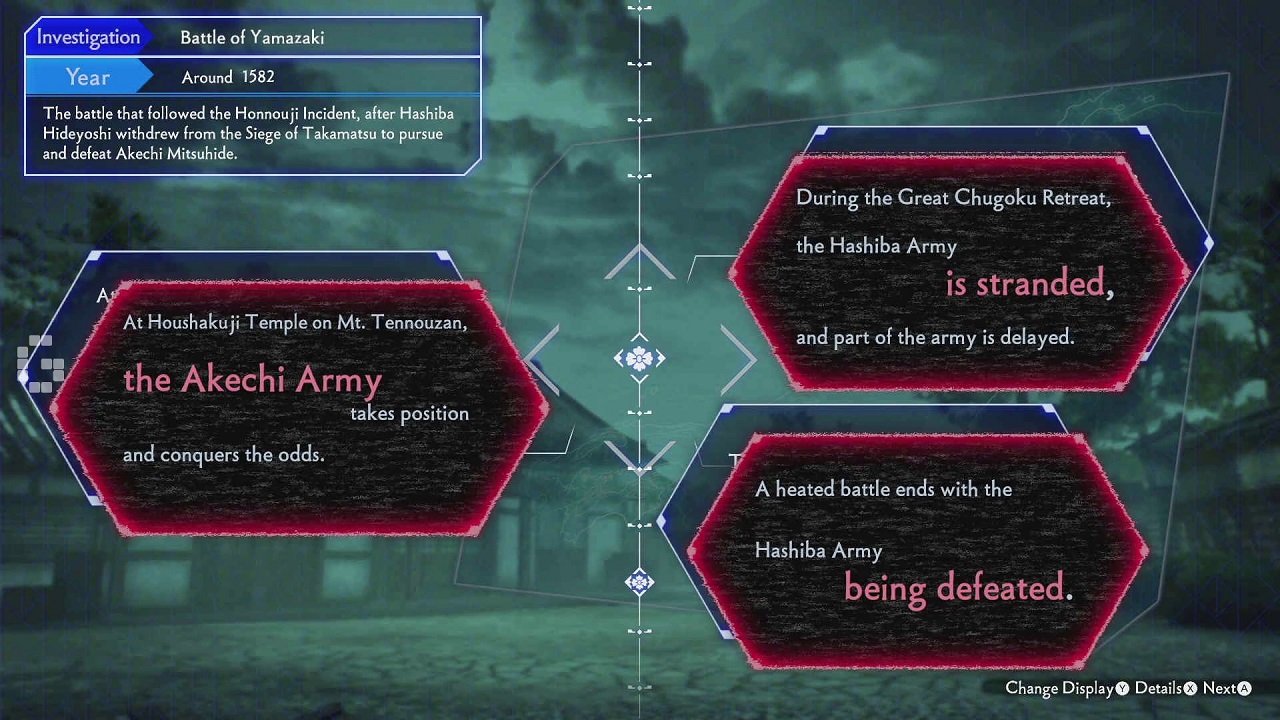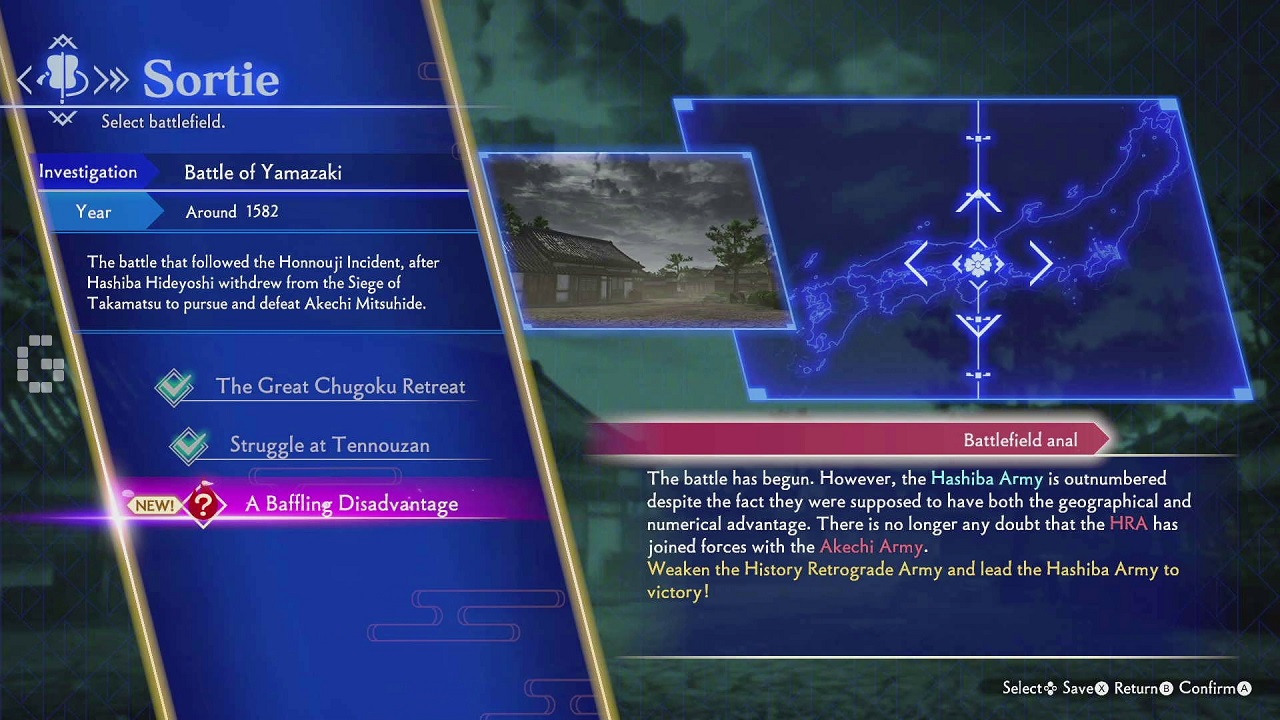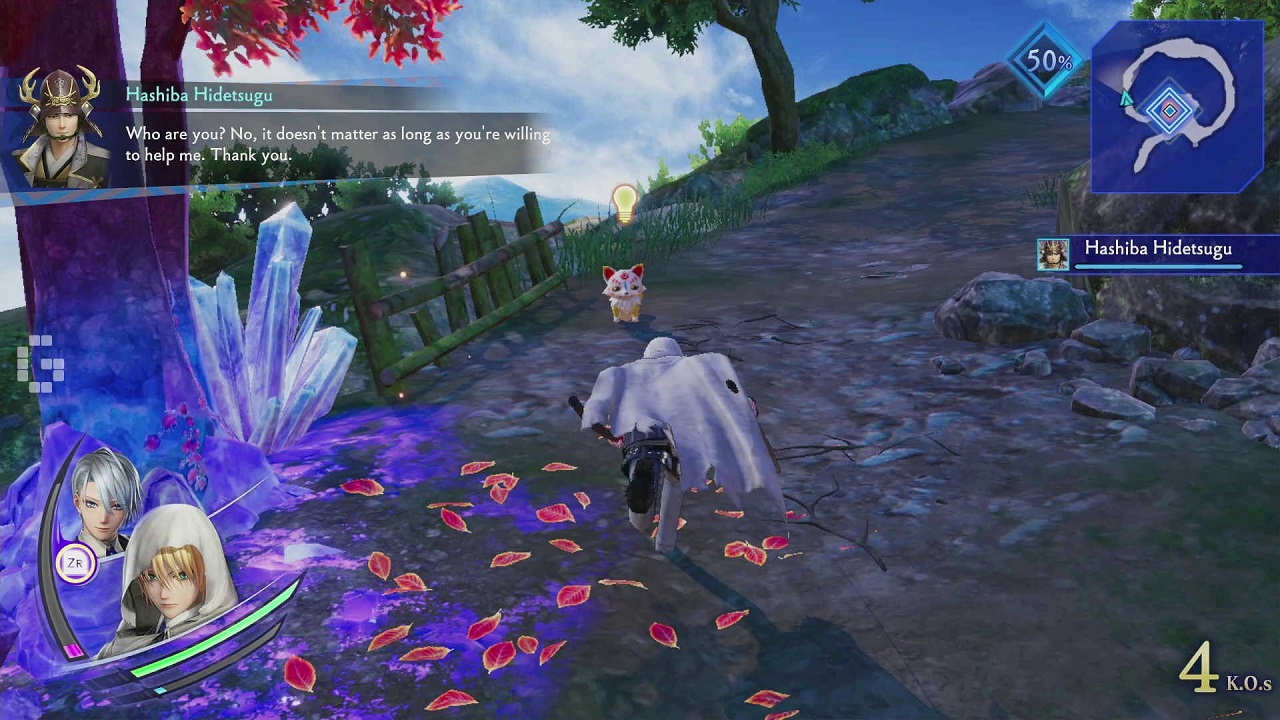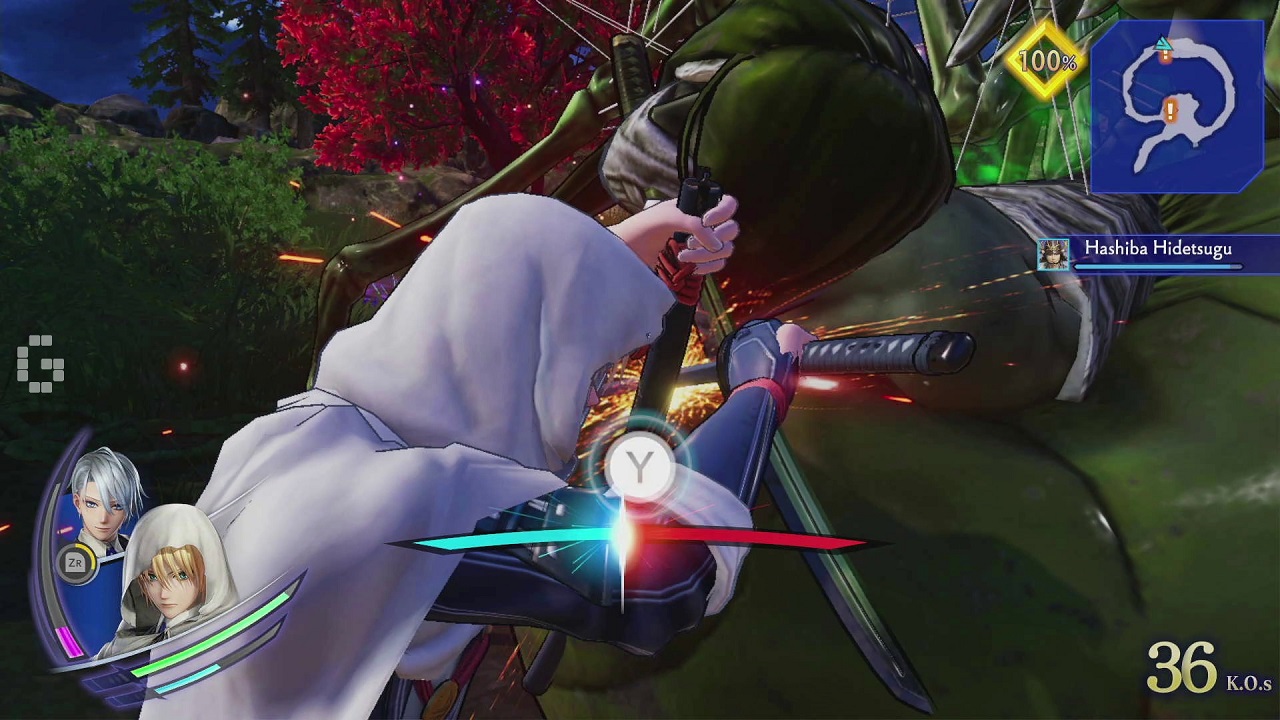Touken Ranbu Warriors has finally reached the hands of the non-Japanese speakers in English, about 3 months since its original Japanese release. The game is available for Nintendo Switch and PC via Steam, with the Steam version having up to 4K support and 60 FPS.
For the record, this review is based on the Nintendo Switch version.
HANDLE SWORD WITH CARE
The options menu is not very extensive, with things like:
- System
- Difficulty: Easy / Normal / Hard. On Easy, dodges are automatic
- Vibration On / Off
- Auto / Manual Lock-on
- Display Enemy HP: All / Strong Enemies Only / None
- Battle Hints On / Off
- Message Speed: Slow / Normal / Fast / Instant
- Subtitles On / Off
- DLC Outfit Applicable Location: Honmaru / Honmaru and Replay
- Camera
- Vertical / Horizontal: Standard / Inverted
- Speed: Slow / Slightly Slow / Normal / Slightly Fast / Fast
- Sound
- Music / SFX / Voice
The control schemes can be changed between “Easy Mode” and “Regular Mode”, with Easy Mode allowing you to just do a single button mash. Unusually enough, you’re allowed to remap the buttons on the Nintendo Switch. We have the technology!!!

HISTORY LESSON WITH THE LADS
As the story goes, the 15 playable sword boys – Touken Danshi – reside at a honmaru which does not have a master. Nonetheless, Konnosuke and the bureaucracy of the oblique Time Government task them to maintain the history’s timeline, in the hopes that they may someday be able to welcome their master home. As they travel back and forth incidents that are key to each team member’s respective histories, they are joined by Omokage, who’s been going solo all this while.
While the fixes seem very linear at first, one does begin to wonder just how far reaching the History Retrograde Army is…

For the fans, the story is actually both quite intriguing and immersive, seeing how the swords, while acknowledging their roles as weapons, do note that some of the “real timeline” events are quite unsavoury. After all, a number of these are predicated on ensuring key members die.

I have to emphasize for the fans, as I don’t think the game does a very good job at establishing the links between them. It does get said in text later on to a degree, but if you don’t already have the context, you might be wondering why the hell Yamanbagiri Chougi is being such a little shit to Yamanbagiri Kunihiro, for example. You can get a little more interaction between the characters as all of them have Bond Conversations with each other, some of them unlocking only after completing enough story missions.
IN A FLURRY OF SAKURA
It’s honestly quite astonishing how many different animations each attack can have depending on you prior inputs or combos: sure, they all have roughly the same base animation, but they do each have their own flair. The recycled animations aside, the characters respond differently to characters they end up getting paired with, which makes it more unique. The camera really sucks ass sometimes though.

There’s also something to be said about the character models and their physics as they flow quite well, and sometimes get stuck – both in the expected way because of how much fabric there is, and the buggy way. The OST is quite nice too as each sword has their own leitmotif, separate from the ones they already have in the browser game.

All the lads have their voice actors reprise their roles as you might expect, besides Omokage who’s new to this title. The 3D models admittedly have some jank in the in-game cutscenes over the pre-rendered ones, but they’ve given enough thought to make them expressive as they converse. Incidentally, the localization seems to be different from the Johren browser game, with several terms left untranslated and honorifics used. I can’t speak for the browser game since my main account is on the Japanese side, but I did find some of the dialogue amusing. Make of that what you will.

All DLC are cosmetics, and are practically priced akin to daylight robbery for more music, honmaru backgrounds and internal affairs outfits. If you’re a doting saniwa with more cash to spare, then feel free to dole out the koban for your beloveds.
Additionally, there’s a photo mode with a selection of filters, stickers, and the like. I didn’t play around with this all that much.
MORE FRAMES THAN A BROWSER
I say this with nothing but affection, but yes, Touken Ranbu Warriors is a much more interactive game than the original game, and way higher polygon count. I still have no idea how I kept playing the original game, and indeed, do wonder what exactly people spend so much on in the browser game – resources, one supposes – but that’s neither here nor there. Anyway.

The core gameplay loop of Warriors is heading into the various instanced areas and mowing down several hundred History Retrograde Army (HRA) troops while trying to fulfill any given objectives. This can be as easy as just mashing all the buttons you’re allowed to, to missions requiring a little more finesse. Some battles can have “hidden” objectives needing you to stray off the linear path to actually clear the mission, or you’ll get a fail state. Fortunately, even if you miss it the first time, trying again will let you see what it is so that you’re never unclear on your goals. Konnosuke can also assist you, an option you can turn off if you prefer.

Maybe your target suddenly becomes an enemy, so you’ll have to be careful not to accidentally take them out. You could get a “stealth” mission that somewhat leans on the fourth wall regarding the mechanics. This isn’t a stealth-based game after all. Generally speaking, just fire off your combos and watch the lads show off their stuff in their special moves, or make some flashy combo with their partner whoever it may be. The more powerful attacks can’t be spammed, as you might expect.
It’s quite easy to get the swords to strip as it happens either on number of hits taken, or damage. You can have someone at 90% HP when their clothes spontaneously rip off, which allows them to charge up their Super faster. They get different voicelines too! The partner sword may or may not also strip, but they can’t actually die until you do so don’t worry about them. They can also strip without you. Truly a string of words that look questionable out of context, Sengo would be proud.
To get you used to the controls and have Emo Kise start his path of character development, the initial chapter only has you control Yamanbagiri Kunihiro and Chougi for the most part. They can get bond dialogue once they return to the honmaru when they reach certain thresholds, and having higher bond also means better combat partners. Anyone you’ve left malewife-ng at the honmaru might be selectable to sortie at random, sometimes also potentially providing bonuses to EXP, resource gain, and the like. Once you’ve cleared a stage, you can repeat it with any duo you prefer for the level grinding. Unfortunately, any story-stage dialogue cannot be skipped so be prepared to hear the same retorts repeatedly.

Characters left at the honmaru do also get EXP each time you return from any sortie, though the level difference would understandably get pretty wide if you’re relying solely on passive EXP gain. When you return, you can opt to play some mini-games that can differ by area, offering bond EXP, koban, or resources where relevant. Mini-games can be quite frustrating depending on which one you get; I’m looking at you, you stupid foxes. Honmaru levels unlock more room space, then later, items in the shop.

Aside from pure levels, the sword boys can be further upgraded with skill boards to unlock equippable item slots, increase their stats or add new skills to their repertoire. This should be fairly self explanatory. On Normal mode, the grind kicks in about 13 hours in with the colour-swapped enemies getting beefier and your units needing a lot more material to upgrade, and shop items getting pricier. You will want to grind for Bond between members, too, not just for their conversations, but also for Partner Counters / Follow-Ups in battle.

The game itself is fairly linear with starting chapters focusing on a specific team guaranteed to sortie with the honmaru members selected at random. The lads may come with random bonuses, for increased resource gain, bond EXP or good ol’ EXP. It does feel like the later you go, the more passive EXP you can get, which is pretty good to cut down on some of the grind.
よきかなよきかな
Considering how many popular characters that weren’t included in this game, one does wonder if there’ll be an eventual sequel. There’s plenty of history that they can still cover, like how the stage plays and musicals have done. The (absurdly expensive) DLC is entirely cosmetic, adding in new backgrounds, music and outfits, with “no plans for additional content beyond the DLC items listed”, so there’s room there if they so wish. The loading time isn’t too bad on the Switch, though I think some of the mini-games would be best on a controller.
All in all, Touken Ranbu Warriors can be first and foremost be considered a fanservice game, and quite the well-made one at that. If you simply want a musou experience with some Japanese history lessons thrown in, you can’t really go very wrong with this game.
| PROS | CONS |
|---|---|
| Storyline is both intriguing and educational | Leans closer to needing prior context |
| Highly enjoyable as a fanservice game both mechanically and in presentation | Camera control problems |
| DLC is cosmetic only, but also really pricey | While not mandatory, some mini-games are worse than others |
| Can get quite grindy later |












![[EXCLUSIVE] Inside Japan’s Indie Game Revolution – An Interview with BitSummit Organizer Masahiko Murakami](https://cdn.gamerbraves.com/2025/05/BitSummit-Orgainzer_Interview_FI-360x180.jpg)
![[EXCLUSIVE] The Art of Adaptation: Developer Interview Details the OVERLORD Mobile RPG Lord of Nazarick](https://cdn.gamerbraves.com/2025/05/Lord-of-Nazarick_Interview_FI-360x180.jpg)
![[EXCLUSIVE] Taking Gundam in Bold New Directions – Interview with GQuuuuuuX Director Kazuya Tsurumaki](https://cdn.gamerbraves.com/2025/04/Kazuya-Tsurumaki_Interview_FI-1-360x180.jpg)


![[SEA Exclusive] From Shadows to Shipwrecks – Jennifer English Talks About Bringing Emotional Depth to Clair Obscur: Expedition 33](https://cdn.gamerbraves.com/2025/04/Clair-Obscur-Jennifer-English_Interview_FI-360x180.jpg)

![[EXCLUSIVE] Do the Game Interview – An Intimate Look at the Challenges of Game Development](https://cdn.gamerbraves.com/2025/04/Do-the-Game_Interview_FI-1-360x180.jpg)
![[EXCLUSIVE] Interview with the Minds Behind of Den of Wolves – 10 Chambers’ New Sci-Fi Heist FPS](https://cdn.gamerbraves.com/2025/04/Den-of-Wolves_Interview_FI-360x180.jpg)












![[GUIDE] SD Gundam G Generation Eternal Unit Tier List](https://cdn.gamerbraves.com/2025/04/SD-Gundam-G-Generation-Eternal-Tier-List_Review_FI-360x180.jpg)